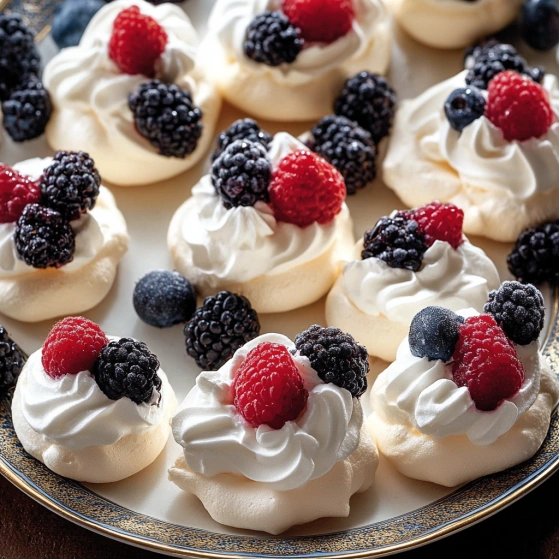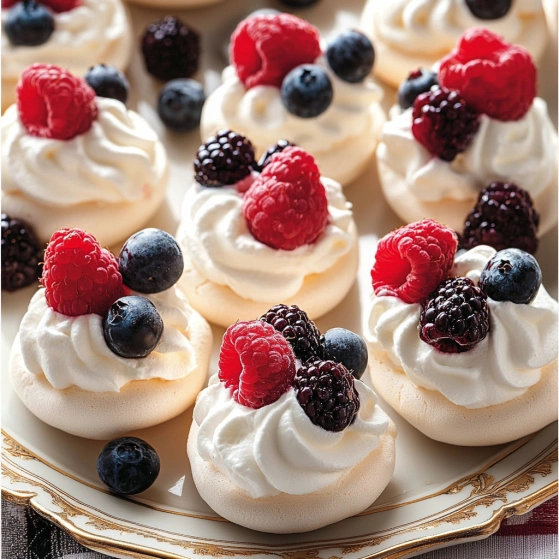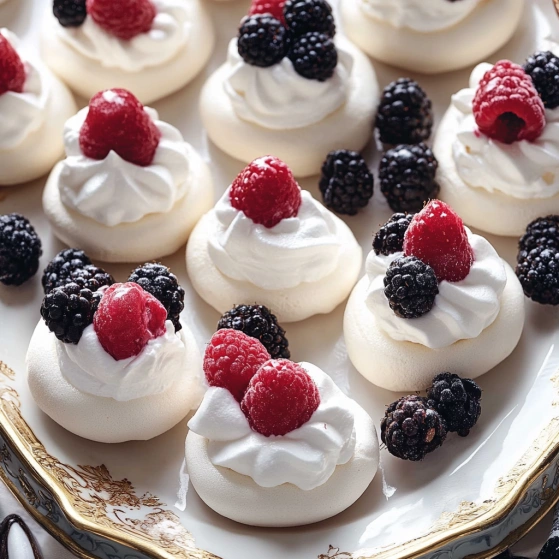 Pin it
Pin it
This soft-as-cloud mini pavlova recipe creates the perfect balance of crisp meringue shells with pillowy centers. These elegant desserts may look fancy, but they're surprisingly simple to make with just a few ingredients and some patience.
I first made these mini pavlovas for a summer garden party where I needed a light dessert that wouldn't weigh guests down. They were such a hit that they've become my signature dessert for everything from casual family gatherings to more formal dinner parties.
Ingredients
- Egg whites: from 4 large eggs at room temperature gives the best volume and stability for your meringues
- Granulated sugar: one cup provides the perfect sweetness and helps create that crisp exterior
- Cornstarch: one tablespoon is the secret to achieving that marshmallowy center
- Vanilla extract: one teaspoon adds depth of flavor without competing with the fruit toppings
- Heavy cream: whipped to soft peaks creates a luscious cloud for the fruit to rest on
- Fresh seasonal fruits: especially berries or kiwi bring color, acid, and freshness to balance the sweetness
Step-by-Step Instructions
- Prepare Your Equipment:
- Start with absolutely clean equipment as any trace of fat will prevent egg whites from whipping properly. Wipe your mixing bowl and beaters with lemon juice or vinegar to ensure they're grease free. Preheat your oven to 250°F and line a baking sheet with parchment paper.
- Whip The Egg Whites:
- Begin beating room temperature egg whites on medium speed until they become foamy. This usually takes about 2 minutes in a stand mixer. The foam should look like soft bubbles before moving to the next step.
- Gradually Add Sugar:
- With the mixer running on medium high add the sugar one tablespoon at a time waiting about 30 seconds between additions. This slow process ensures the sugar fully dissolves creating a glossy stable meringue. The meringue is ready when it holds stiff peaks and feels smooth between your fingers with no gritty sugar texture.
- Add Cornstarch And Vanilla:
- Sprinkle the cornstarch over the meringue and add the vanilla extract. Fold these in gently with a rubber spatula using no more than 10 strokes to maintain as much volume as possible.
- Shape Your Pavlovas:
- Spoon or pipe the meringue onto your prepared baking sheet creating 6 to 8 even mounds about 3 to 4 inches in diameter. Use the back of a spoon to create a slight depression in the center of each mound where your toppings will go later.
- Bake Low And Slow:
- Place the pavlovas in your preheated oven and immediately reduce the temperature to 225°F. Bake for about 1 hour until the exteriors are dry and crisp but not browned. They should feel light and sound hollow when tapped gently.
- Cool Completely:
- Turn off the oven but leave the pavlovas inside with the door slightly ajar for at least 1 hour. This gradual cooling prevents cracks from forming as the meringues come to room temperature.
- Add Toppings:
- Just before serving whip the heavy cream until soft peaks form. Spoon a generous dollop onto each pavlova and arrange your fresh fruit on top. Finishing with a light dusting of powdered sugar adds a beautiful final touch.
 Pin it
Pin it
My favorite part of making these mini pavlovas is watching guests take their first bite. There's always that moment of surprise when the crisp exterior gives way to the marshmallowy center, creating the perfect textural contrast with the cream and fresh fruit. My daughter calls them "cloud cookies" and insists we make them for every special occasion.
The Secret To Perfect Meringue
Weather matters tremendously when making meringues. Humidity is the enemy of crisp pavlovas, so try to make them on a dry day if possible. If you live in a particularly humid climate, you might need to extend the baking time slightly and be extra careful with the cooling process. I learned this the hard way during a rainy summer day when my pavlovas remained stubbornly sticky instead of developing that beautiful crisp shell.
Troubleshooting Common Issues
Weeping meringues usually indicate that your sugar wasn't fully dissolved during the whipping process. Be patient and add the sugar very gradually. Beading those little sugary droplets on the surface happens when meringues are baked at too high a temperature. Keep your oven low and steady. Cracking is often caused by rapid temperature changes, which is why the slow cooling period in the oven is so important. If your pavlovas do crack, don't worry just cover the imperfections with extra whipped cream.
Creative Serving Variations
Transform these mini pavlovas into an interactive dessert bar by preparing the shells ahead of time and setting out bowls of different toppings. Try lemon curd with blueberries for a tangy twist, chocolate ganache with raspberries for something more decadent, or passionfruit pulp for a tropical flavor profile. During winter months when fresh berries are expensive, try using poached pears or roasted stone fruits instead. For adult gatherings, a splash of liqueur like Chambord in the whipped cream adds sophisticated flavor.
 Pin it
Pin it
Frequently Asked Questions
- → Why did my pavlovas crack or collapse?
Pavlovas typically crack when exposed to sudden temperature changes. Cool them gradually by turning off the oven and leaving the door slightly ajar. Over-beating egg whites or using high baking temperatures can also cause collapsing. Ensure your oven is properly calibrated and add cornstarch which helps stabilize the meringue.
- → Can I make mini pavlovas ahead of time?
Yes! The meringue shells can be made 1-2 days in advance and stored in an airtight container at room temperature. However, only add the whipped cream and fresh fruit shortly before serving to prevent the meringue from becoming soggy.
- → What's the difference between pavlova and meringue?
While both are made from whipped egg whites and sugar, pavlovas include cornstarch and sometimes vinegar which creates a marshmallow-soft center beneath the crisp exterior. Traditional meringues are typically crisp throughout. Pavlovas are also specifically served with cream and fruit toppings.
- → How can I ensure stiff peaks when beating egg whites?
Use room temperature egg whites and ensure your mixing bowl and beaters are completely clean and free of any grease or yolk. Start beating at a medium speed until foamy, then increase to high. Add sugar gradually while continuing to beat until stiff, glossy peaks form that stand straight up when the beaters are lifted.
- → What fruits work best for topping pavlovas?
Berries (strawberries, raspberries, blueberries) and kiwi are traditional choices as their tartness balances the sweet meringue. Other excellent options include passion fruit, mango, peaches, or pomegranate seeds. Choose fruits that provide both color contrast and complementary flavors to the sweet meringue and cream.
- → Can I make mini pavlovas without cornstarch?
While cornstarch helps create the signature soft center of pavlovas, you can substitute an equal amount of white vinegar or lemon juice which serves a similar purpose of stabilizing the egg whites. The texture may be slightly different but still delicious.
